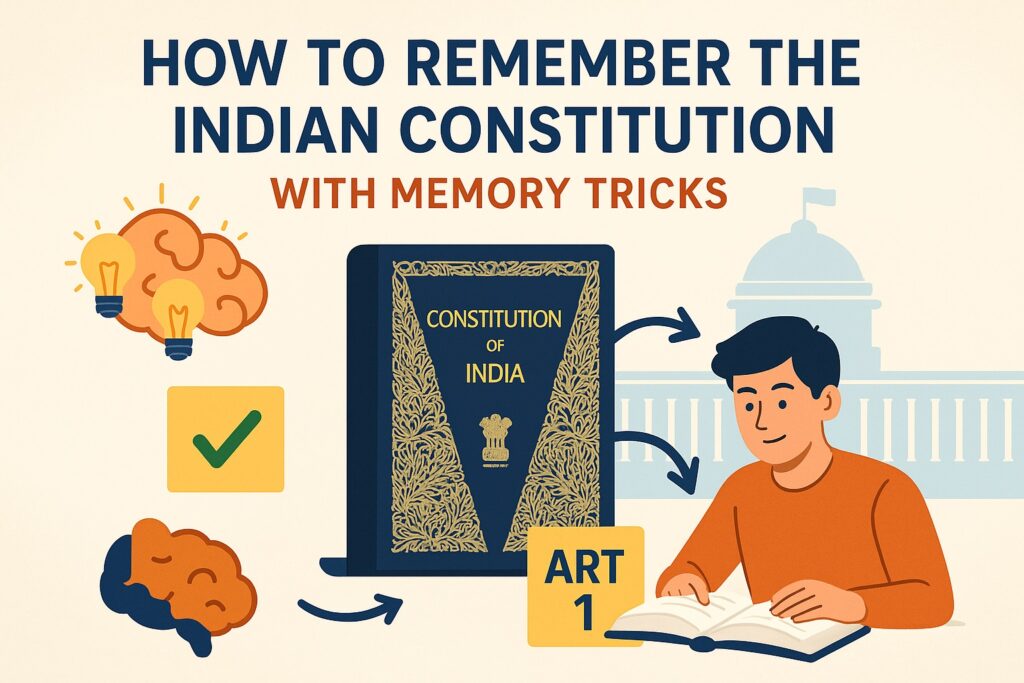Here is some super effective and fun tips and tricks to help you remember important aspects of the Indian Constitution more easily. And guess what? I’ve saved the funniest and most memorable trick for the end—so make sure to stick around!
1. Two Key Dates in Constitutional History
Let’s start with two of the most important dates related to the Indian Constitution:
- 26th November 1949: The day the Constitution was adopted.
- 26th January 1950: The day the Constitution came into effect.
Why January 26? Because on this day in 1929, the Indian National Congress declared “Purna Swaraj” or complete independence from British rule. To honor this historic day, January 26 was chosen for enforcing the Constitution—now celebrated every year as Republic Day.
2. From Then to Now: Constitution Stats
- Originally: 395 Articles, 22 Parts, 8 Schedules
- Currently: 448 Articles, 25 Parts, 12 Schedules
Despite these changes, one fact remains unchanged: India has the longest written Constitution in the world.
3. Understanding Schedules and How to Remember Them
What Are Schedules?
Schedules are tables in the Constitution that provide additional information not present in the Articles.
For instance, Articles 346 and 347 discuss official languages, but the actual list of these languages is given in the 8th Schedule.
India has 22 official languages listed there.
The 12 Schedules at a Glance:
- Territories – Names of States and Union Territories
- Emoluments – Salaries of officials
- Oaths & Affirmations – For constitutional posts
- Rajya Sabha Seats Allocation
- Scheduled Areas & Tribes
- Northeastern States (Autonomous Districts)
- Federal Structure – Distribution of powers (Union, State, Concurrent Lists)
- Official Languages
- Land Reforms – Laws immune to judicial review (added in 1951)
- Anti-Defection Laws
- Panchayats
- Municipalities
Trick to Remember All 12 Schedules:
“Tears of Old PM”
Each letter corresponds to a schedule:
- T – Territories (1st)
- E – Emoluments (2nd)
- A – Affirmations (3rd)
- R – Rajya Sabha (4th)
- S – Scheduled Areas (5th)
- O – Other (Northeast) Areas (6th)
- F – Federal Structure (7th)
- O – Official Languages (8th)
- L – Land Reforms (9th)
- D – Defection (10th)
- P – Panchayats (11th)
- M – Municipalities (12th)
4. Why Separate Schedules Instead of Articles?
When the Constitution was enacted, it already had over 105,000 words. Adding all that detail directly into Articles would’ve made it overly complicated. So, to simplify, information was split into Articles, Parts, and Schedules.
5. Source Countries: Where the Constitution Took Inspiration From
When India’s Constituent Assembly began drafting the Constitution (1946-47), it borrowed elements from 11 different countries. Here’s a trick to remember them and their respective features:
A. Ireland – Trick: “Elise DP is No.1”
- Election of President
- Directive Principles of State Policy
- Nomination to Rajya Sabha
B. UK – Tricks:
- “Parle Biscuit”:
- Parliamentary System, Rule of Law, Law-making Process, Bicameralism, Single Citizenship
- “CNBC is a Complexion” – Alternative with similar elements
C. USA – Trick: “President Needs Fund for Removal of VP & Judges”
- President as Commander-in-Chief
- Fundamental Rights
- Impeachment
- Preamble, Vice-President, Judiciary Independence
D. Canada – Trick: “Can I Know Fed’s Address?”
- Federation with Strong Centre
- Advisory Jurisdiction of Supreme Court
- Residuary Powers
6. Parts of the Constitution and Memory Tricks
Originally there were 22 Parts, now we have 25. New Parts and Articles are added alphabetically, e.g., Article 21A.
Three Mnemonics to Remember 25 Parts:
Trick 1 (Covers All 25 Parts):
“You Can Fly Directly From US UP, Meet Child Shyam, Ram’s Fruit Tastes Sweet to Eat. So Only Eat Maggi As Tasty Snack.”
Each initial maps to a Part.
Trick 2 (Parts 11–16):
“Read From the Start to End Please”
Simple phrase to cover these six parts.
Trick 3 (Parts 17–22):
“LEMATS”
- Each letter stands for a part between 17 and 22.
Conclusion
With the help of fun mnemonics like “Tears of Old PM” and quirky phrases like “Elise DP is No.1”, understanding and memorizing the Indian Constitution becomes much more engaging. I hope you found these tips helpful and enjoyable!

